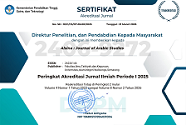Qalam AI: A Study on the Potential of Automatic Ḥarakat Detection for Arabic Sentence Learning
DOI:
https://doi.org/10.21580/alsina.7.2.27500Keywords:
Arabic NLP, Automatic Diacritization, Computer-Assisted Language Learning, Error Analysis, Natural Language ProcessingAbstract
This research aims to investigate the capabilities of Qalam AI – an automatic ḥarakat (diacritical mark) detection system – in supporting Arabic sentence learning through its ablility to analyze sentence components. This research was an exploratory study that employed a case study approach on the implementation of Qalam AI in the classroom. Data collection methods included: 1) analysis of student text samples, 2) expert evaluation by comparing Qalam AI’s analysis results with manual analysis by Arabic language experts, and 3) simulation of integration in the classroom. The analysis focused on three grammatical cases: 1) al-asmāʾ al-marfu̅ʿah (nominative), 2) al-asmāʾ al-manṣūbah (accusative), and 3) al-asmāʾ al-majrūrah (genitive). The research analysis used qualitative methods to examine Qalam AI's potential applications in Arabic language pedagogy.
Downloads
References
Alzahrani, Abdulaziz. “A Systematic Review of Artificial Intelligence in Education in the Arab World.” Revista Amazonia Investiga 11, no. 54 (August 30, 2022): 293–305. https://doi.org/10.34069/ai/2022.54.06.28.
Arnolus Juantri E. Oktavianus, Lamhot Naibaho, and Djoys Anneke Rantung. “Pemanfaatan Artificial Intelligence Pada Pembelajaran Dan Asesmen Di Era Digitalisasi.” Jurnal Kridatama Sains Dan Teknologi 05, no. 2 (2023): 473–76. https://doi.org/https://doi.org/10.53863/kst.v5i02.975.
Chassignol, Maud, Aleksandr Khoroshavin, Alexandra Klimova, and Anna Bilyatdinova. “Artificial Intelligence Trends in Education: A Narrative Overview.” Procedia Computer Science 136 (2018): 16–24. https://doi.org/https://doi.org/10.1016/j.procs.2018.08.233.
Choiroh, Muhimmatul. “EVALUASI PEMBELAJARAN BAHASA ARAB BERBASIS MEDIA E-LEARNING.” Bahasa Arab NASKHI Jurnal Kajian Pendidikan Dan Bahasa Arab 3, no. 1 (2021): 41–47. https://doi.org/https://doi.org/10.47435/naskhi.v3i1.554.
Edgar, Thomas W., and David O. Manz. “Exploratory Study.” Research Methods for Cyber Security, 2017, 95–130. https://doi.org/10.1016/B978-0-12-805349-2.00004-2.
Ekantiningsih, Piksa Dewi, and Dadang Sukirman. “Trends of Education and Training Teacher Competency in Information and Communication Technology.” Jurnal Inovasi Teknologi Pendidikan 10, no. 1 (2023): 87–105. https://doi.org/10.21831/jitp.v10i1.52630.
Fadli, Failasuf, and Mochamad Iskarim. “STUDENTS’ PERCEPTIONS OF ARTIFICIAL INTELLIGENCE TECHNOLOGY TO DEVELOP 21 ST CENTURY LEARNING SKILLS.” Lentera Pendidikan: Jurnal Ilmu Tarbiyah Dan Pendidikan 27, no. 1 (2024): 178–90. https://doi.org/https://doi.org/10.24252/lp.2024v27n1i11.
Fahraini, Sovia, and Muhammad Fikri Almaliki. “Analysis of Arabic against The Use of Artificial Intelligence (AI) through Tashkeel (Automatic Harokat) Application to Increase Maharah Qiraah.” In Proceeding International Conference on Education, 64–77, 2023.
———. “Analysis of Arabic against The Use of Artificial Intelligence (AI) through Tashkeel (Automatic Harokat) Application to Increase Maharah Qiraah.” International Conference on Education, 2023, 64–77. https://jurnalfaktarbiyah.iainkediri.ac.id/index.php/proceedings/article/view/1740.
Farid, Edi Kurniawan. “Sintaksis Bahasa Indonesia Dan Bahasa Arab (Studi Analisis Kontrastif Frasa, Klausa, Dan Kalimat).” Jurnal Bahtsuna 2, no. 1 (2020): 1–23. https://doi.org/10.55210/bahtsuna.v2i1.70.
Fui-Hoon Nah, Fiona, Ruilin Zheng, Jingyuan Cai, Keng Siau, and Langtao Chen. “Generative AI and ChatGPT: Applications, Challenges, and AI-Human Collaboration.” Journal of Information Technology Case and Application Research 25, no. 3 (2023): 277–304. https://doi.org/10.1080/15228053.2023.2233814.
Helaluddin, and Hengki Wijaya. Analisis Data Kualitatif. 1st ed. Sekolah Tinggi Theologia Jaffray, 2019. https://books.google.co.id/books?hl=id&lr=&id=lf7ADwAAQBAJ&oi=fnd&pg=PA1&dq=teori+analisis+kualitatif&ots=CbRUNWTQaS&sig=CurF8a50-76IpLnh74xdSyCvBZY&redir_esc=y#v=onepage&q=teori analisis kualitatif&f=false.
Junifer, Siregar. “Buku Morfologi.” Morfologi, 2021, 5–20.
Luthfan, Muhammad Aqil, and Syamsul Hadi. “Morfologi Bahasa Arab: Reformulasi Sistem Derivasi Dan Infleksi.” Alsina : Journal of Arabic Studies 1, no. 1 (2019): 1. https://doi.org/10.21580/alsina.1.1.2599.
Mahbubi, Abdillah. “Conventional and Contemporary Arabic Language Teaching Methods: A Comparative Analysis.” Alsina : Journal of Arabic Studies 6, no. 2 (2024). https://doi.org/https://doi.org/10.21580/alsina.6.2.23307.
Munir, Munir. “Pendekatan Struktural Dalam Pelajaran Bahasa Arab.” Shaut Al Arabiyyah 6, no. 1 (2018): 13–24. https://doi.org/https://doi.org/10.24252/saa.v6i1.5644.
Musawi, Ali Al, Abdullah Al Hashmi, Ali Mahdi Kazem, Fatima Al Busaidi, and Salim Al Khaifi. “Perceptions of Arabic Language Teachers toward Their Use of Technology at the Omani Basic Education Schools.” Education and Information Technologies 21, no. 1 (2016): 5–18. https://doi.org/10.1007/s10639-013-9305-5.
Owan, Valentine Joseph, Kinsgley Bekom Abang, Delight Omoji Idika, Eugene Onor Etta, and Bassey Asuquo Bassey. “Exploring the Potential of Artificial Intelligence Tools in Educational Measurement and Assessment.” Eurasia Journal of Mathematics, Science and Technology Education 19, no. 8 (2023). https://doi.org/https://doi.org/10.29333/ejmste/13428.
Park, Joonhyeong, Tang Wee Teo, Arnold Teo, Jina Chang, Jun Song Huang, and Sengmeng Koo. “Integrating Artificial Intelligence into Science Lessons: Teachers’ Experiences and Views.” International Journal of STEM Education 10, no. 1 (2023). https://doi.org/https://doi.org/10.1186/s40594-023-00454-3.
Phan, Thi Ngoc Le. “Students’ Perceptions of the AI Technology Application in English Writing Classes.” Proceedings of the AsiaCALL International Conference 4 (2023): 45–62. https://doi.org/https://doi.org/10.54855/paic.2344.
Rehan Anwar, Muhammad, and Herdi Aziz Ahyarudin. “AI-Powered Arabic Language Education in the Era of Society 5.0.” IAIC Transactions on Sustainable Digital Innovation (ITSDI) 5, no. 1 (2023): 50–57. https://doi.org/https://doi.org/10.34306/itsdi.v5i1.607.
Rishanda, Aflah Tamami, Koderi Koderi, Fachrul Ghazi, and Ahmad Nur Mizan. “Artificial Intelligence Dalam Pembelajaran Nahwu Secara Mandiri.” Al Mi’yar: Jurnal Ilmiah Pembelajaran Bahasa Arab Dan Kebahasaaraban 8, no. 1 (2025): 27–39. https://doi.org/http://doi.org/10.35931/am.v8i1.4594.
Rizki, Restu Budiansyah. “Istirātījiyyat Qirā’at Kutub Al-Turath ‘ala Asās Naẓariyyat Rebecca Oxford Fī Ta ‘allum Al-Lughat Al-Ajnabiyat.” Alsina: Journal of Arabic Studies 1, no. 1 (2019): 67–86. https://doi.org/http://dx.doi.org/10.21580/alsina.1.1.3725.
———. “Kajian Linguistik Modern Strukturalis Dalam Pembelajaran Bahasa Arab.” Alsina : Journal of Arabic Studies 2, no. 2 (November 6, 2020): 173. https://doi.org/10.21580/alsina.2.2.4968.
Rizki, Restu Budiansyah, Muhammad Fatkhur Rizal, and Chusnia Rahmawati. “Design of Integrating Qalam AI and Language Teacher Competencies in Evaluating Arabic Reading Skill” 4, no. 2 (2024): 257–66. https://doi.org/https://doi.org/10.31869/afl.v4i2.5930.
———. Evaluasi Pembelajaran Bahasa Arab Berbasis Integrasi Teknologi AI Dan Manusia. Edited by Abdul Ghofur. Jombang: LPPM Unhasy, 2025.
———. “Students’ Perceptions of Integrating Qalam AI and Teacher Competencies in Arabic Reading Instruction.” LISANIA: Journal of Arabic Education and Literature 8, no. 2 (2024): 188–207. https://doi.org/https://doi.org/10.18326/lisania.v8i2.188-207.
Rizki, Restu Budiansyah, Fathur Rohman, and Abdul Ghofur. “TAṬWĪR AL-WASI̅LAH AT-TA ‘LI̅MIYYAH AL-ILIKTRU̅NIYYAH AL-MU ‘TAMADAH ALA̅ ASA̅S WE̅BLOG LI DA ‘MI NAMU̅ŻAJ AT-TA ‘LI̅M AL-MAD ‘U̅M BI AL-WE̅B (WEB ENHANCED COURSE).” Al Mi’yar: Jurnal Ilmiah Pembelajaran Bahasa Arab Dan Kebahasaaraban 6, no. 2 (2023): 697–728. https://doi.org/http://dx.doi.org/10.35931/am.v6i2.2564.
Seo, Kyoungwon, Joice Tang, Ido Roll, Sidney Fels, and Dongwook Yoon. “The Impact of Artificial Intelligence on Learner–Instructor Interaction in Online Learning.” International Journal of Educational Technology in Higher Education 18, no. 1 (2021). https://doi.org/10.1186/s41239-021-00292-9.
Tjahyanti, Luh Putu Ary Sri, Putu Satya Saputra, and Made Santo Gitakarma. “PERAN ARTIFICIAL INTELLIGENCE (AI) UNTUK MENDUKUNG PEMBELAJARAN DI MASA PANDEMI COVID-19.” Jurnal Komputer Dan Teknologi Sains (KOMTEK) 1, no. 1 (2022): 15–21.
U.S. Department of Education, Office of Educational Technology. Artificial Intelligence and Future of Teaching and Learning: Insights and Recommendations. Washington, DC, 2023.
Valin, Robert D Van, and Randy J LaPolla. Syntax: Structure, Meaning, and Function. Cambridge University Press, 1997.
Walter, Yoshija. “Embracing the Future of Artificial Intelligence in the Classroom: The Relevance of AI Literacy, Prompt Engineering, and Critical Thinking in Modern Education.” International Journal of Educational Technology in Higher Education 21, no. 1 (2024). https://doi.org/10.1186/s41239-024-00448-3.
Xie, Haoran, Hui Chun Chu, Gwo Jen Hwang, and Chun Chieh Wang. “Trends and Development in Technology-Enhanced Adaptive/Personalized Learning: A Systematic Review of Journal Publications from 2007 to 2017.” Computers and Education 140, no. May (2019): 103599. https://doi.org/10.1016/j.compedu.2019.103599.
Published
How to Cite
Issue
Section
License

This work is licensed under a Creative Commons Attribution-NonCommercial-ShareAlike 4.0 International License.
Copyright
The copyright of the received article shall be assigned to the publisher of the journal. The intended copyright includes the right to publish the article in various forms (including reprints). The journal maintains the publishing rights to published articles. Authors are allowed to use their articles for any legal purposes deemed necessary without written permission from the journal, but with an acknowledgment to this journal of initial publication.
Licensing
In order for Alsina: Journal of Arabic Studies to publish and distribute research articles, the editors need publishing rights (transferred from author to publisher). This agreement relates to the transfer/publishing copyright license to Alsina: Journal of Arabic Studies but the authors still have significant rights to use and share their published articles.
Alsina: Journal of Arabic Studies supports the need for writers to share, disseminate and maximize the impact of their research and their rights on any database. As a journal article writer, you have the right to various uses of your articles, including that by the institution or company where you work. Copyright can be used without the need for special permission. Authors who publish articles in the Alsina: Journal of Arabic Studies have broad rights to use their work for teaching and scientific purposes without requesting permission, including:
- Use by the author for lectures, presentations, or conferences, with distribution of copies to participants;
- Distribution to colleagues for research use;
- Use in compilations of the author's subsequent work;
- inclusion in a thesis or dissertation;
- Reuse of sections or excerpts from articles in other works (with full acknowledgment of the final article);
- Preparation of derivative works (other than commercial purposes) (with full acknowledgment of the final article);
- Voluntary posting on open websites operated by authors’ or writers' agencies for scientific purposes
When submitting a manuscript, authors do so on the understanding that if accepted for publication, the copyright for publishing (publishing right) of the article shall be assigned/transferred to Alsina: Journal of Arabic Studies.
Authors whose articles are accepted for publication will receive confirmation via email and sent a Copyright Transfer Agreement.

 Accreditation
Accreditation 
 In Collaboration with
In Collaboration with 

 Visitors
Visitors  Article Template
Article Template





